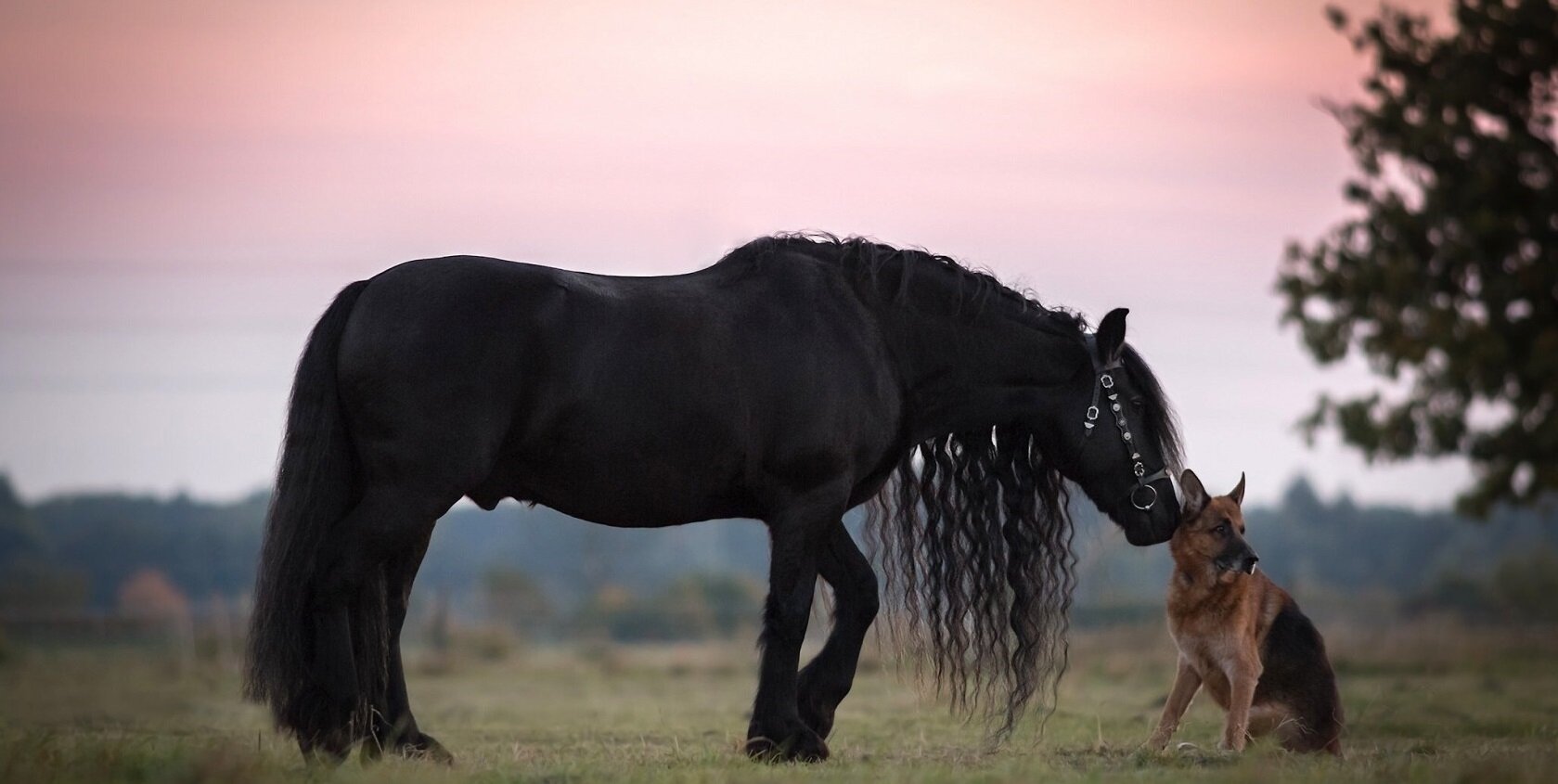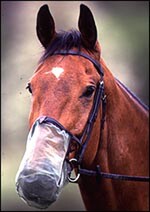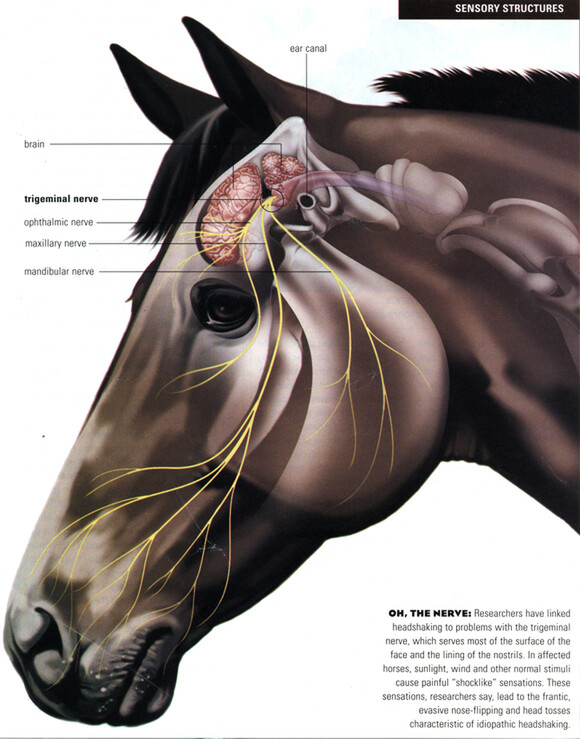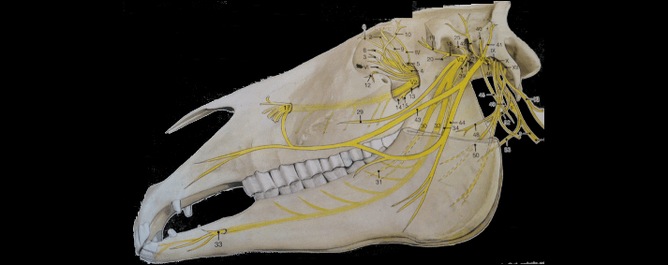In the last few months I have had a few cases of head shakers. A lot of us do not really understand what the true meaning of a head shaker is, there are certainly different levels of head shaking and it is multi-factoral. What may have worked for someone else may not work on your horse. Thus, I figured the more people of aware of the syndrome the more we can help our equine partners.
Horses can be exquisitely aware of the slightest sensation, such as a small insect on its back or face. Rippling of skin or an occasional head shake is a normal response to the tickling trigger of nerve endings. But, there are times when a horse can't stop shaking or tossing its head to a seemingly inapparent sensation; such behavior is known as headshaking.
Headshaking behavior is thought to be caused by overactivity of branches of the trigeminal nerve that supply sensation to the face and muzzle. A horse's behavioral reflex causes him to flip his head, snort or sneeze, rub his head, or take evasive action. Most headshaking horses (89% of them) flip their head vertically, according to research findings.
Head Shaking May Have a Variety of Causes:
All horses shake or toss their heads from time to time. Some horses, however, exhibit the behavior far more often than others. In cases where head shaking is so frequent or violent that it interferes with the horse’s comfort or use, an effort should always be made to uncover and eliminate the cause.
Tracking down the reason for this annoying (and occasionally dangerous) behavior can be a lengthy and difficult. Asking questions about the horse’s habits is the first thing in solving the puzzle.
- In horses that toss or shake their heads only when ridden, the problem may be caused by pain. Have an equine dentist do a thorough oral exam to make sure the teeth do not have sharp points or edges that are irritated by the pressure or position of the bit. In young horses, the shallow-rooted wolf teeth sometimes interfere with the bit and can easily be removed by a qualified dentist or veterinarian.
- Subtle lameness or back pain can be a cause of head tossing as the horse tries to find relief from discomfort. If the behavior occurs when the horse is asked to flex or work in a collected frame, thus having a AMRT session may benefit your horse in releasing tension and aiding in eliminating the head shaking.
- Watch while a trainer or more advanced rider gets on the horse. No owner likes to hear that his rough hands are the problem, but if the horse goes well for another person, a subtler touch on the reins may eliminate head tossing
- Tiedowns, martingales, side reins, and more severe bits usually don’t fix head shaking. Paradoxically, some difficult horses perform better in a milder bit (thicker mouthpiece, shorter shanks) rather than one that promises more control. Other horses that fuss and fidget with a bit are far more contented when ridden in a bosal, hackamore, or side-pull bridle. Any bit should be properly fitted so that it does not pinch the horse’s mouth. If you aren’t absolutely certain the bit is the right size or in the right position, ask a professional for help
- Other reasons for head tossing or shaking may be high energy levels at the beginning of the ride or resentment of whip or spurs. A turnout or longeing before a ride can help an energetic horse settle into his work. A trainer may be able to evaluate the use of, and the horse’s response to, spurs and whip.
Does the horse toss or shake his head in the field or stall as well as under saddle?
Some horses are sensitive to strong sunlight. Exposure to bright light causes a nerve in the head (trigeminal nerve) to send a shock-like sensation to the horse’s face, and he reacts by violently flinging his head up and back. This type of head shaking is typically worst in the summer but is also seen on bright winter days. A horse with this condition, called photic head shaking, may also sneeze or snort frequently, and may try to rub his nose or face against his legs or other objects. Affected horses like to stand in the shade or at least keep their heads shaded by a barn, hedge, or pasture buddy. Some owners have found that the behavior stops if the horse wears a facemask to shade the eyes. The drug cyproheptadine and sometimes a combination of cyproheptadine and carbamazepine has been in helpful in some horses. Confer with your vet.
- Many horses have had dramatic improvement with use of fringe, net, covering of lower part of the face. A common trick is using a tube of mesh from stockings or pantyhose and to sew it to noseband of the bridle / halter. So that it gently hugs the horses muzzle. It is not known why it affects the head shaking though the idea is that the sensation of the fringe interrupts the painful pain firing.
A treatment for headshaking with a favorable success rate in 40% of cases is a face mask with a nose net. "The nose net provides a mechanical stimulus, like sticking a finger on your nose, which sends afferent (conducting) impulses up the nerve so it quits firing. Not all horses are improved with nose nets." It appears to give the horse dramatic relief.
Acupuncture/ Myofascial release therapy appears to also give major relief to some horses. A particular horse that was getting a AMRT session and had a visible and dramatic relief from the continuous head shaking and was able to relax and have a snooze without the annoying and painful nerve signal. The extent of the horse’s head shaking had reduced considerably by the next session.
Some studies show higher head shaking instances in geldings, nearly twice as often as mares. John Madigan, DVM, MS, Dipl. ACVIM, a professor of veterinary medicine at the University of California, Davis, is recognized as the leading expert on equine headshaking syndrome. Years of examining difficult cases have led him to question why this phenomenon is seasonal-- as many as two-thirds of headshaking cases occur in spring.
Madigan says there is a rise in reproductive hormones called gonadotropins in the spring, and this is normally associated with the breeding season typical of horses. He explains,
"This surge occurs as days lengthen. Geldings have no testosterone feedback, so they have higher levels of gonadotropins, like FSH (follicle-stimulating hormone) and LH (luteinizing hormone), for a period of time."
How do gonadotropins influence the trigeminal nerve? Madigan explains, "The hormones seem to affect some part of the trigeminal ganglia, altering its chemistry and rendering it unstable. (Ganglia provide relay points and connections between nerves.) As normal sensory 'traffic' comes into the trigeminal ganglia, then additional triggers like light, sound, smell, or exercise may stimulate this nerve to 'fire.'
"The horse then receives neuropathic pain such as burning, itching, tingling, or electriclike sensations, any of which are manifestations of horses with headshaking," he adds.
Madigan explains how exercise might trigger headshaking behavior: "The autonomic activity of exercise initiates a lot of activity in the nasal area, such as engorgement of the nasal turbinates and snorting that is normal to clear the nostrils so the horse doesn't inhale dust or debris. Higher speeds and more effort ramp up stimulation within the head, each stimuli increasing 'traffic' in the trigeminal area."
Madigan notes two other primary risk factors for headshaking:
A horse that has gained weight, as, for example, during a layoff; A horse that does not regularly perform aerobic exercise.
Madigan proposes a therapeutic protocol that he has found successful in treating headshaking:
Measure gonadotropins (LH) and lower their levels by administering daily melatonin (12-16 mg) at 5 p.m. This "tells" the horse's body that it is winter. He reports good results for seasonal headshakers.
Feed the label dose (4 ounces) of magnesium oxide (Quiessence) to raise the threshold for "firing" of the trigeminal nerve.
Feed the label dose of spirulina (a homeopathic product) to raise the threshold of for firing of the trigeminal nerve.
Madigan stresses that it may take four to eight weeks until results are appreciated with this combination of therapies. There are a multitude of factors involved, you should always try and determine the circumstances, explain problem to your vet and have to go through a process of elimination to help the horse.
Level 1
Expression calm and relaxed in all activities..
Level 2
Rubs nose on stall or other objects, sneezes or coughs, stamping, dislikes grooming, may shake head vertically. May be spooky and distracted. May rub nose on legs, even while moving forward.
Level 3
Stares, disconnected from the environment and focused on self, ears twitching, tightens chin, flips nose downward, horizontally or otherwise shakes head 0-2 times in 15 minutes.
Level 4
Sneezes, coughs, slightly agitated, flips nose downward in sudden, extreme movements (approximately 1-5 times in 15 minutes), rubs nose on legs or any other object nearby. May become light sensitive at this point.
Level 5
Entire neck may become involved with up and down vertical and repetitive movements, the horse becomes more agitated, headshaking increases to 5-15 times in 15 minutes. May strike with legs at nose, becomes panicky and either won't move forward or wants to run.
Level 6
More continuous headshaking at 15-30 times a minute. May become extremely panicked and frantic to the point of hurting himself or others around him, headshaking 30 - too numerous to count.





